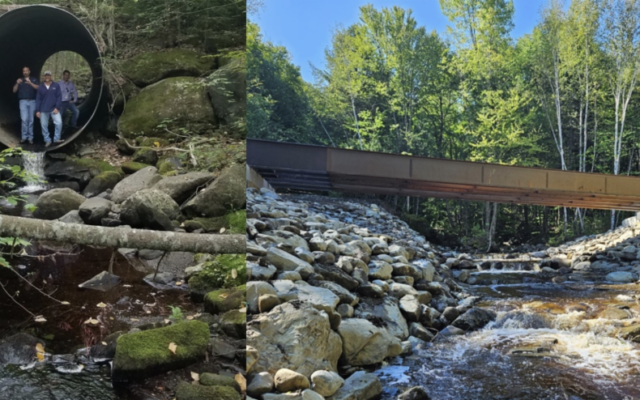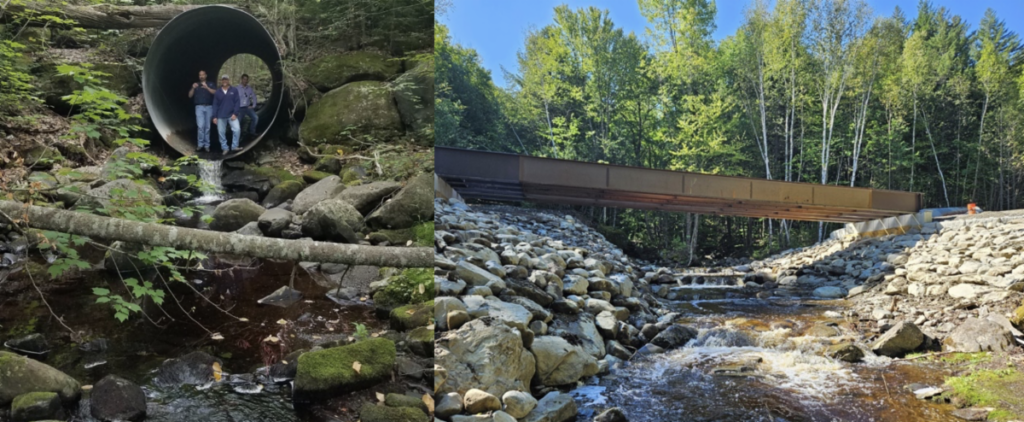
Atlantic salmon benefit from stream reconnection in Pleasant River Headwaters Forest
Access to 13.9 miles of stream habitat has been restored in the Pleasant River Headwaters Forest for endangered Atlantic salmon and Eastern brook trout following the completion of 14 road-stream-crossing projects this summer.
Thirteen of these projects took place on small streams on land owned by the Appalachian Mountain Club in the heart of the 100-Mile Wilderness and the final project was located at Henderson Brook in the corridor of the Appalachian National Scenic Trail. The 100-Mile Wilderness is part of the largest contiguous expanse of undeveloped forest in the eastern United States. This is an area with a high resilience to climate change and an expansive number of lakes and streams with excellent habitat for cold-water fish.

CULVERT REPLACEMENT — This culvert, left, on the KI Road prevented brook trout and Atlantic salmon from migrating to 8.2 miles upstream habitat in Henderson Brook. The culvert was replaced with a 70-foot-long bridge, right, that will need minimal maintenance over the next 75 to 100 years.
Two of the crossings were decommissioned, and 12 were replaced with open-bottom culverts or large bridges. All the crossings were designed to withstand extremely high stream flows associated with severe weather events, providing resilience for the vital road network connecting recreational lands and commercial forests with the communities of Greenville and Brownville.
“The habitat restoration work taking place in the Pleasant River Headwaters Forest is proof that the Appalachian Mountain Club’s Maine Woods Initiative model works,” said Steve Tatko, AMC vice president of Conservation Research and Land Management and area native. “We are grateful to work with partners to implement conservation projects that integrate recreation, outdoor education, and rural economic development. Paired with our forest management program, watershed restoration expands the impact that our forests have on global ecosystems. Returning sea-run fish to their native homes in a forest that is forever protected is as much about the environmental benefits as it is the right thing to do. The Appalachian Mountain Club is honored to deliver on its mission to foster the protection, enjoyment, and understanding of the outdoors in this way.”
“We are thrilled to be a partner in these projects with AMC,” said John Burrows, the Atlantic Salmon Federation’s executive director for U.S. Operations. “The Pleasant River has the largest amount of accessible, high-quality habitat for Atlantic salmon in the Penobscot. A quarter century ago, Atlantic salmon could not reach the upper Pleasant because of a gauntlet of five dams between Brownville and Veazie. Only one of those dams remain, and Atlantic salmon are now spawning in the upper Pleasant River.”

UPSTREAM CULVERT — Maranda Nemeth, the Maine Headwaters project manager with ASF, stands next to a culvert upstream.
“Reopening rivers and streams to fish migration is critical in the recovery of species like Atlantic salmon,” said Carrie Selberg Robinson, director of the NOAA Fisheries Office of Habitat Conservation. “NOAA is proud to be supporting the work of the Atlantic Salmon Federation and Appalachian Mountain Club to reconnect habitat on the Pleasant River.”
These crossing projects are supported by a grant from NOAA Fisheries with funding made available through the Bipartisan Infrastructure Law and Inflation Reduction Act. Through this funding, NOAA is working to support fisheries and coastal communities across the country through habitat restoration and climate resilience efforts.
The projects were constructed by Sargent Corporation from Orono and by William London and Son of Milo. Additional partners include the Maine Department of Marine Resources, The Nature Conservancy in Maine, the Appalachian Trail Conservancy, the National Park Service, and Acadia Civil Works.
In 2024, ASF and AMC will complete an additional 12 crossings in the Pleasant River Headwaters Forest.